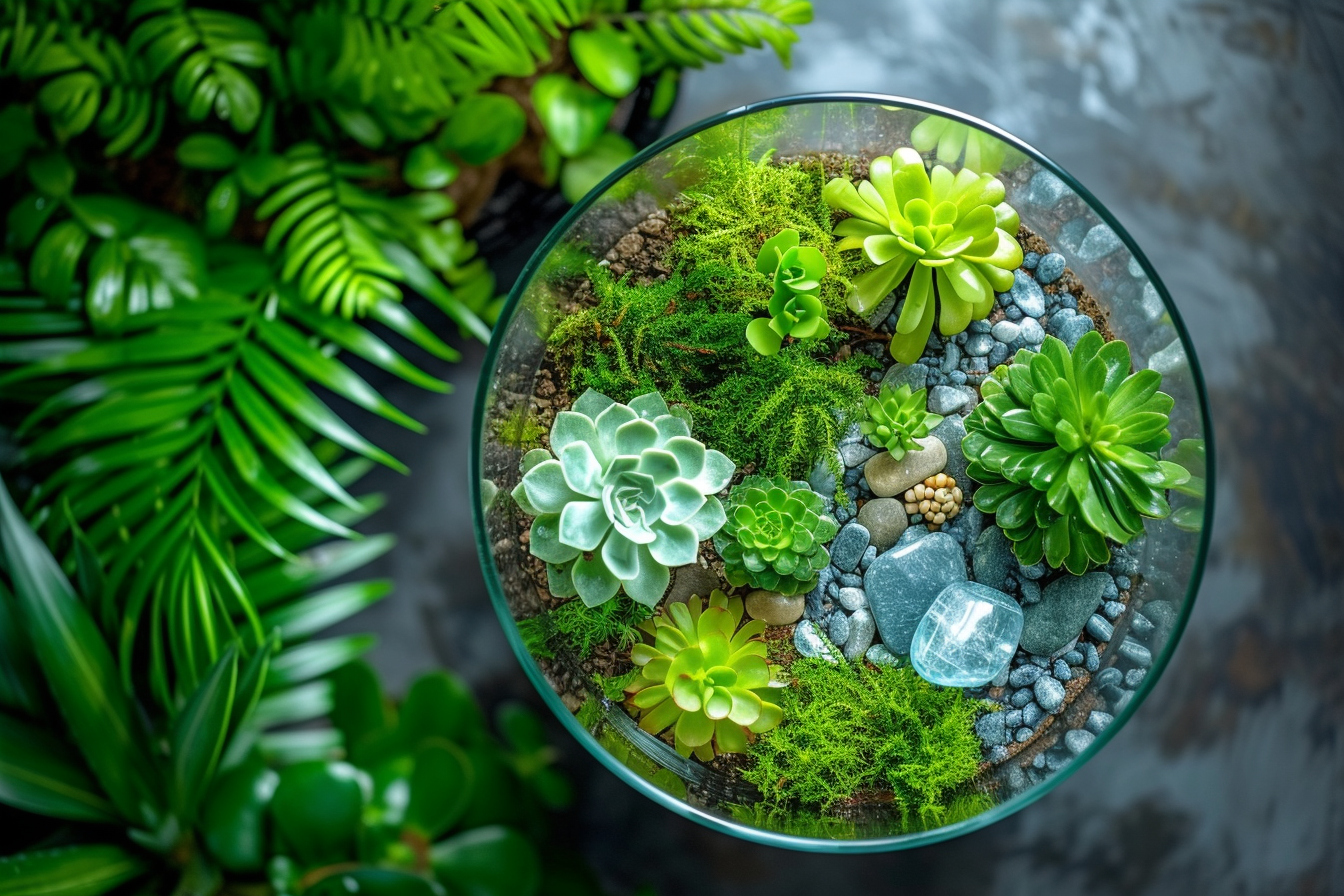Terrariums bring a slice of nature into your home, creating a miniature landscape of tranquility and beauty. These small, self-contained ecosystems are not only stylish and modern; they’re also easy to make and maintain. A well-crafted terrarium can serve as an eye-catching centerpiece, a conversation starter, or a calming presence in any room. Let’s delve into the steps and strategies that will help you build your very own verdant display.
Choosing your terrarium container
Before you begin, selecting the right container is vital. Glass containers are the most popular choice due to their transparency, which allows a clear view of the terrarium’s internal beauty. They come in various shapes and sizes, from spherical bowls to rectangular tanks. When selecting your container, consider the space where the terrarium will be displayed and ensure that the size is appropriate. Also, decide on whether you prefer an open or closed terrarium, as this will influence the type of plants you can grow.
Selecting suitable plants
Plant selection is the next critical step. Terrariums can either be lush with tropical plants or arid with succulents and cacti, depending on the environment you wish to create. Factors such as light, humidity, and growth patterns must be considered when picking plants. For closed terrariums, choose species that thrive in high humidity and moderate temperatures, such as ferns, mosses, and air plants. For open terrariums, opt for succulents, cacti, or other drought-resistant plants that prefer a dry environment.
Considering plant compatibility
Creating a harmonious mini-ecosystem means selecting plants that coexist well in similar conditions. It’s crucial to group plants with similar sunlight and watering needs to ensure that each species thrives without outcompeting the others.
Understanding terrarium layers
Layering the terrarium correctly is fundamental for both drainage and aesthetics.
The drainage layer
At the bottom, a drainage layer collects excess water, preventing plant roots from becoming waterlogged, which could lead to rot. Materials such as pebbles, gravel, or broken pot shards are ideal for this purpose. Ensure this layer is at least one to two inches deep, depending on the size of your container.
The charcoal layer
Just above the drainage layer, spread a thin layer of activated charcoal. This material keeps the water clean by absorbing impurities and preventing mold and bacteria growth, which are common concerns in the humid environment of a terrarium.
The soil layer
After the charcoal, add the soil layer, which will be your plants’ home. Use potting soil appropriate for the plants you’ve selected—tropical plants generally need a more moisture-retentive mix, while succulents and cacti require a mix with excellent drainage.
Arranging your plants
Plant arrangement is both an art and a science. Begin with the tallest or largest plants, positioning them towards the back or center, depending on your terrarium’s viewability. Play with different placements before planting to see what looks best. Once satisfied, remove the plants from their pots, tease out the roots gently, and create a hole in the soil large enough to accommodate each plant. After placing a plant, press the surrounding soil to secure it. Repeat this process with all plants, ensuring they have enough space to grow.
Design considerations
Balance is essential in your design. Consider variations in color, texture, and height to create a visually appealing miniature landscape. Remember to leave open spaces and avoid overcrowding your terrarium for a cleaner look.
Adding finishing touches
With the vegetation in place, add final touches like decorative stones, moss, figurines, or driftwood to enhance the terrarium’s visual appeal. These elements should complement, not overpower, the natural beauty of the plants.
Moisture and watering
Managing moisture levels is crucial, especially for closed terrariums. They should be watered sparingly, as the enclosed nature of the container means water can’t easily escape. Open terrariums will require more frequent watering but be careful not to overwater, as standing water can cause the roots to rot.
Monitoring your ecosystem
After watering, monitor your terrarium’s moisture levels by observing the condensation patterns. If the container walls are consistently wet, leave the terrarium open for a few hours to let some moisture escape. Conversely, if the soil appears too dry, lightly mist the plants to maintain the necessary humidity.
Location and light
Terrariums need proper lighting to thrive. Most terrarium plants require bright, indirect light. Direct sunlight can overheat the terrarium and scorch the plants, especially in closed containers. Find a spot that receives consistent, indirect sunlight or use artificial plant lights as an alternative.
Temperature considerations
Ensure that your terrarium is placed in an area with a stable temperature that is suitable for the plants within. Avoid placing it near radiators, air conditioners, or windows that may create a draft or fluctuating temperatures.
Maintenance and care
Ongoing care is light but necessary. Watch for signs of stress in plants, such as yellowing leaves or stunted growth, which may indicate a need for intervention—either in watering habits, lighting, or placement. Trimming overgrown plants will help maintain your terrarium’s structure and prevent any one plant from dominating the space.
Regular observation
Regularly check on your terrarium and enjoy how the ecosystem evolves. Observing changes, such as new growth or changes in the soil or water cycle, can inform you of the health of your terrarium and whether any adjustments are needed. Plus, it is fascinating to see the slow and intricate ways nature unfolds in your own miniaturized garden.
Crafting stunning terrariums is a rewarding and creative DIY project that adds a touch of greenery to your environment. With the right materials, thoughtful selection of plants, and proper care, you can establish and maintain a thriving miniature ecosystem. Whether you’re a seasoned green thumb or a novice plant enthusiast, building and maintaining a terrarium is an enriching experience that brings a unique blend of art, nature, and science to your living space. As your skills and confidence grow, so too will the complexity and beauty of your terrariums.

Leave a Reply